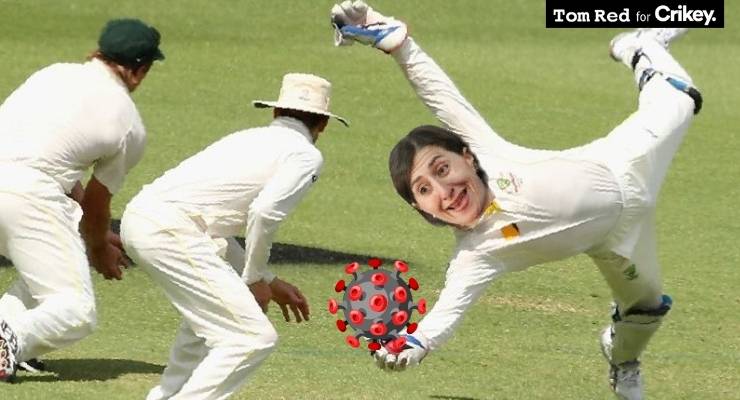
On Thursday, up to 12,000 sports fans are expected to file into the Sydney Cricket Ground (SCG) to watch Australia play India in the third Test.
Despite attendance numbers being cut to 12,000 from 24,000, experts remain deeply concerned about staging a potential super-spreader event while Sydney is in the middle of an outbreak.
It’s politically risky, too.
Leaders around the world have paid the price for misreading the public mood. Prime Minister Scott Morrison delivered Australia’s first example in March when he was forced to reverse his plans to attend an NRL game even as his government banned mass gatherings of more than 500.
‘Dangerous’ mixed messages
University of NSW epidemiologist Professor Marylouise McLaws tells Crikey the decision was “incredibly dangerous” and sent mixed messages on social restrictions.
“It’s a potential accelerant and makes no sense calling for mass COVID-19 testing while putting on a mass gathering,” she said.
“Even with a reduction in numbers, from an outbreak management perspective it’s nonsensical. You’re undoing all the good of mass testing and mandating masks.”
In greater Sydney, just five guests are allowed to visit a household. Weddings are capped at 100 guests, nightclubs have closed, and masks are mandatory in some indoor venues.
McLaws says the number of positive cases from tests in NSW is 0.06%. When adjusting for returned travelers in a crowd of 12,000, three to four people may be infected.
This morning NSW recorded four local COVID-19 cases.
Different social groups will mingle
Head of the epidemiological modelling unit at Monash University James Trauer tells Crikey the timing of the Test is a huge concern because the full effects of the holidays are not yet known.
“People have had Christmas with their extended family,” he said. “The virus incubates for the week, then people have associated with friend groups for New Year’s and social gatherings … before associating again in the workplace.”
Trauer says people from different postcodes and social groups will mingle.
“It’s got the potential to derail some of the progress made in NSW by getting people who wouldn’t normally be in contact with one another to mix,” he said.
“These broader associations have the potential to take small clusters and link them into extended chains of transmissions which will lead to extended outbreaks.”
Risks still not mitigated
The SCG will have a reduced capacity of 25%. Those who have visited COVID-19 exposure sites in the past 14 days will not be permitted entry. Masks are strongly recommended but not mandated.
The venue is broken up into eight sections, and attendees have to sit in their allocated section and row and have been asked to allow two seats between themselves and other groups.
La Trobe University epidemiologist Associate Professor Hassan Vally tells Crikey that although the new capacity limit eased some of his concerns, many logistical questions have not been answered: how attendees will enter and exit; how they’ll be stopped from mingling with the other seven sections while queuing at toilets and food stalls; can they socially distance themselves on public transport when going to and leaving the match?
Social distancing might go out the window if it rains and crowds huddle under shelters, he says.
“We’re in a situation where we’re pushing the odds,” he said. “If someone has COVID-19 [and] turns up [to the match] it’s really unlikely they won’t pass it on to other people.
“If the decision-makers are rolling the dice and willing to take the risk, and if the worst scenario happens — they clearly have to be accountable.”
He also wonders whether the decision to cut crowd numbers as cases tracked downwards was based on logic or a reaction to public pressure.
“If their logic was sound and based on evidence, what’s informed the change?” he said. “It makes you lose confidence in the process.”
Venues NSW chairman Tony Shepherd says the SCG has added extra security staff and social distancing marshals and has increased cleaning.
What’s the political fallout?
Leaders risk undermining the public’s trust if they have to later reverse policies they insisted were safe.
Whether or not the public believes the Test should go ahead, an outbreak at the SCG would trigger questions about NSW Premier Gladys Berejiklian’s decisions. So far she has managed to limit the spread of COVID-19 throughout the state but another major outbreak could quickly waste her political clout.
Has the NSW government made the right decision on the Sydney Test? Let us know your thoughts by writing to letters@crikey.com.au. Please include your full name to be considered for publication in Crikey’s Your Say column.









Crikey is committed to hosting lively discussions. Help us keep the conversation useful, interesting and welcoming. We aim to publish comments quickly in the interest of promoting robust conversation, but we’re a small team and we deploy filters to protect against legal risk. Occasionally your comment may be held up while we review, but we’re working as fast as we can to keep the conversation rolling.
The Crikey comment section is members-only content. Please subscribe to leave a comment.
The Crikey comment section is members-only content. Please login to leave a comment.